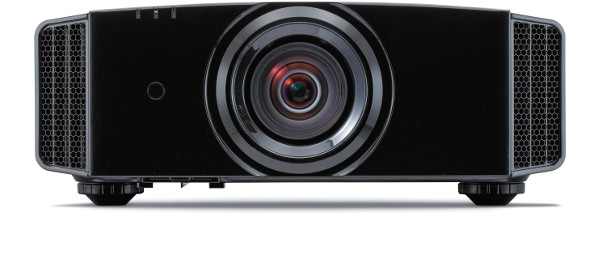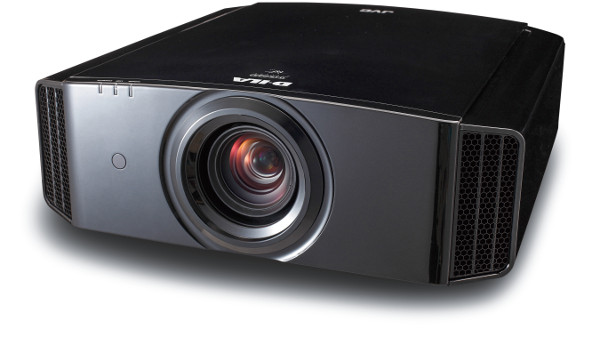JVC DLA-X790R D-ILA Projector Review Page 2
The JVC passed both 3:2HD and MA HD (motion adaptive HD) in our standard HD/SDR video tests, but failed 2:2HD. The JVC won’t accept a native 480i input so the SD tests were irrelevant. It passed both luma and chroma resolution, but clipped both above white and below black. It will pass below black and above white if the Input Level control is changed from Auto (the default) to Enhanced, but the latter resulted in odd settings for the Brightness and Contrast controls, together with a paler image offering reduced HDR pop and contrast. The Enhanced setting did produce better clipping results on test patterns, but overall I preferred the visible result in the Auto position.
The new catchphrase for gamma is EOTF (Electro-Optical Transfer Function). And for HDR, we have a new form of EOTF, called PQ (Perceptual Quantization). As has often been the case in the HDR-capable projectors I’ve tested so far, with standard measurements the PQ curve skews darker than the expected PQ shape. Flat-screen TVs typically don’t have this issue. Some argue that this is merely a result of the fact that projectors can’t produce, on a projection screen, anywhere near the peak light output of a good Ultra HDTV. This is certainly true, but with a proper setup on a screen of domestically acceptable size, none of the projectors I tested looked subjectively dim in HDR. The JVC, however, does offer three controls in the Gamma menu (Picture Tone, Dark Level, and Bright Level) that allow the PQ curve to be tweaked during calibration until it measures closer to the shape we commonly associate with the HDR PQ we routinely find on an HDR-capable Ultra HDTV.
I always recommend a professional calibration for a projector, particularly for a pricey one. But you should put some hours (100 to 200) on the projector before scheduling one, as it takes time for a projection lamp to settle in. All of the observations below were made after complete SDR and HDR calibrations had been performed, following more than 100 hours on the lamp.
HD/SDR
The first things you can’t miss about the DLA-X790R are its superb blacks and shadow detail. This should come as no surprise to those familiar with the company’s projectors. When the picture fades to black in a darkened room, it’s very near true black even after your eyes adjust to the dark. You’ll still be able to make out the screen from the surrounding void (unlike the case with an OLED TV, where the screen completely disappears with such a source). But I feel confidant saying it would be hard to find any true 4K or pixel-shifting 4K projector that can do better. Most do far worse.

On 1080p sources, the picture looked subtly sharper to me with e-shift5 defeated, so all of my observations here about the JVC’s HD/SDR performance were made with it off. I began my viewing with an animated feature. Yes, animation almost always looks good, but not always this good. And animation is a good test for vivid (if not always natural) color and detail. It’s nearly always crisp — so if it isn’t, you know that the error is not in the source. Frozen looked amazing on the JVC, with brilliant color and resolution that could hardly be better even if the disc and display were both true 4K.
Animation rarely has many dark scenes, but both Prometheus and Harry Potter and the Deathly Hallows: Part 2 — two of may favorite black-level torture tests — are loaded with them. To date, I know of no projector that can sort them out better than this JVC — and only a few flat-screen TVs (mostly OLEDs) that can do better. Both of these discs looked richly saturated, with black levels and shadow detail that most projectors can’t approach.
For an older title, I chose Apollo 13. Fleshtones here were a bit too rosy (this appeared to be a disc issue). But backing off to –15 on the Color control helped dramatically without visibly compromising any other colors. Seeing this title on the DLA-X790R was spectacular and like watching it for the first time. The reference-quality launch sequence, the dark of outer space, and the cramped intimacy of the spacecraft’s interior left me with virtually nothing to criticize.
UHD/HDR
The JVC will automatically switch between your calibrated SDR and HDR settings when it sees an HDR source. This includes changing from Low to High lamp modes as required. On my Stewart screen, the JVC peaked out at approximately 145 nits, or about 42 foot-lamberts, in HDR. As with most other projectors, this can’t equal the full HDR experience of a good flat-panel HDTV. But that much peak brightness can still generate decently bright highlights, all the more impressive given my 8-foot-wide screen. And while the color gamut from most current consumer displays is still well short of the ultimate goal of the UHD format, you’re unlikely to complain about the UHD color you’ll get from the JVC. I know I didn’t.

I watched all or part of 15 different Ultra HD Blu-rays for this review, and all but a few provided compelling viewing; again, I’ve not seen better from any other projector at or near the JVC’s price. The best of the discs — Guardians of the Galaxy: Vol. 2, The Great Wall, War for the Planet of the Apes, and (yes!) Trolls — knocked my socks off, with vivid images, crisp detail, and brilliant color (though Apes is more subdued than the others). At least six more of the other discs didn’t disappoint in any way. This included Billy Lynn’s Long Halftime Walk, which the JVC displayed in its native 60 Hz, HDR, with YCbCr 4:2:2, 10 bit color. If those numbers mean little to you, they simply mean that the JVC can display any 4K source with its attendant benefits intact — apart from the use of pixel-shifted resolution enhancement rather than full 4K, as well as the UHD color-gamut limits that all UHD displays remain subject to. (No displays can yet reach full BT.2020 color, and no projector I’ve yet tested can achieve full P3 color limits within the UHD format's BT.2020 container.)
You might well assume that pixel-shifted 4K from a native 1080p projector is inevitably inferior to true 4K using native 4K imaging chips. But the visible resolution from this projector seemed to hold nothing in reserve as I sat 12 feet from my 8-foot-wide screen. I attribute this not only to the cleverness of JVC’s e-shift5 but also to what appears to be a superb optical path and lens.
If I have a reservation about the JVC’s HDR performance, it’s that the blacks in HDR content sometimes crushed very low-level shadow detail — not often or seriously enough to be a major issue, but enough to mention. In Life of Pi there’s a shot in chapter 21 (at 1:23:46) where Pi is shown in deep darkness. On the JVC, the details in his face came close to disappearing, with only his eyes clearly visible. This was not a problem on LG’s 65E7P OLED, suggesting that the issue was not in the source. Raising the JVC’s Brightness control by a few steps helped, but not completely. And more than a few scenes in the first episode of the UHD Blu-ray of Westworld looked crushed and were also better (though not perfect) on the LG OLED. Independence Day Resurgence in HDR was also frequently too dark, though in the same settings the original Independence Day was, ironically, one of the best-looking HDR discs I’ve watched — and possibly the best-looking catalog title to date.
Nevertheless, the issue I just described was only a minor and fleeting concern on a limited number of discs. I had more jaw-dropping moments in UHD/HDR with this projector than with any other projector I’ve yet reviewed.
A Moment for 3D
My 3D testing was brief. The 3D images, via early versions of JVC’s external 3D transmitter and glasses, were fairly dim, even with the projector’s Picture Tone control turned up to maximum (doing the same with the Contrast control produced glare, degraded color, and near-clipping). But on the limited material I watched that has produced 3D ghosting in the past, I saw none.
Conclusions
The JVC DLA-X790R isn’t flawless. But its overall performance with black level, shadow detail, brightness, color, and resolution makes it the best sub-$8,000 projector I’ve yet tested.























































